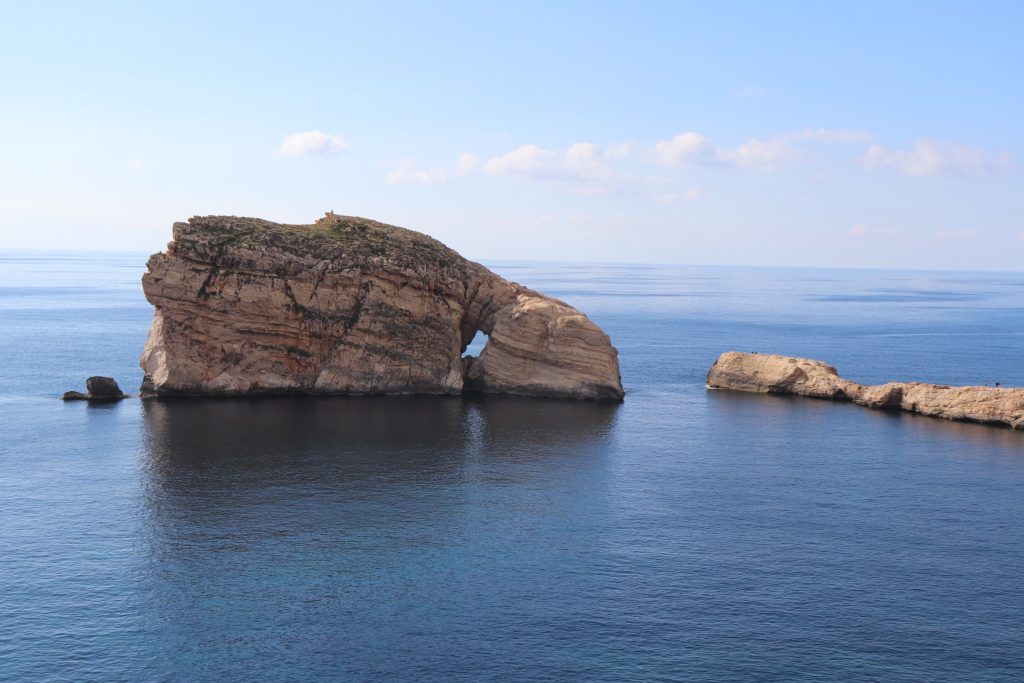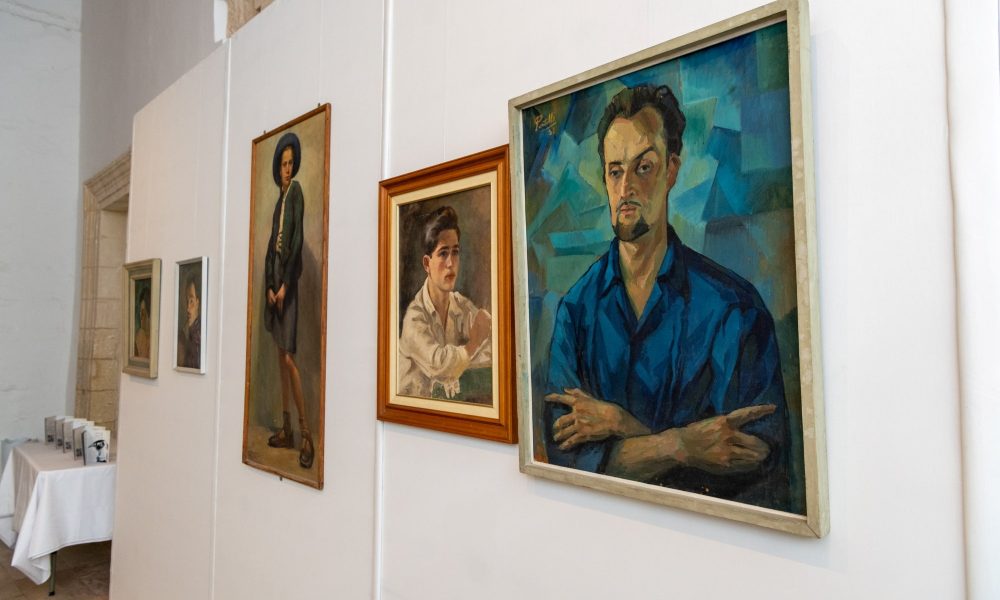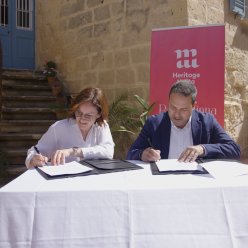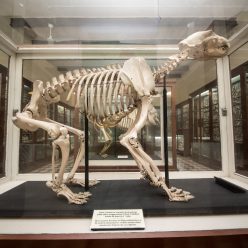by Warren Bugeja and Stephanie Sammut
In the 18th Century, trespassers on the lone 60-metre-high rock that guards the entrance to the circular cliff-backed lagoon of Dwejra in Gozo risked a prison sentence or a three-year spell as oarsmen in the knights’ galley.
To dissuade poachers enticed by the mythical healing properties of a peculiar-looking species growing on The General’s Rock (Il-Ġebla tal-Ġeneral in Maltese), Grand Master Pinto decreed the limestone islet out of bounds in 1746.
Pinto had a guardsman posted to prevent access to the rock, and the sides of the islet smoothed down to discourage handholds. Only high-ranking members of the Order of St John were allowed to collect the highly prized plant, commonly known as the General’s Root. To do this, they crossed over the sinkhole of il-Qala tad-Dwejra, a 50-metre journey from mainland to rock, suspended in a rickety cable-car basket.

Cynomorium coccineum on Kuriat Island, Monastir, Tunisia (Photograph John J. Borg)
Cynomorium coccineum, the object of the Knights’ precarious pilgrimage, belongs to a small family of fleshy plants which are parasitic, feeding on the roots of a few coastal-rupestral plant species. The plant has no leaves, and its flowers are arranged densely on its head region. “The old vernacular name, ‘Maltese Fungus’ is a huge misnomer both because the species is not a fungus and also it is not a species belonging or endemic to Malta,” states Stephanie Sammut, former Curator at the National Museum of Natural History. Stephanie has a particular affinity for this legendary plant as it was the first fluid-preserved specimen she prepared for permanent display at the museum. Therefore, it was no surprise when she selected the plant as her ‘specimen’ of choice within the National Collection for Heritage Malta’s HMTV series ‘Treasure To Meet You.’
“In the past, the plant’s presence was thought to be limited to Fungus Rock in Gozo and was erroneously called the Maltese Fungus for many decades. Some other Maltese vernacular names include Għerq Sinjur, and Fungu Għawdxi,” Stephanie elaborates.
The parasitic plant was first described botanically by Paolo Boccone in 1674, although under another name not as we know it today. In his lavishly illustrated tome ‘Icones et Descriptiones Rariorum Plantarum Siciliae Melitae, Galliae & Italie’ Boccone provides details of the plant’s location. He refers to “Scoglio del Generale” meaning ‘General’s Rock’ and hence its name Herizt tal-Ġeneral (Għerq il-Ġeneral/ The General’s Root). Later in 1750, Giann Piet. Agius De Soldanis, the Gozitan linguist, historian and cleric, sheds some light on the origin of the plant’s appellation, commenting that the plant was referred to as ‘The General’s Root’ because of its high worth and its associated properties. However, a likelier reason, as argued by other historians, is that the name derives from the plant’s discovery in 1600 by the Galera Capitana di Malta.

C.c. in the Natural History Wet Collection (Photograph John J. Borg)
What can be ascertained for sure is that Cynomorium coccineum is a very rare indigenous plant species and the only representative of the Balanophoracease family in Europe. It was present on the Maltese Islands before humankind ever stepped foot on these shores and extends to the sand dunes of North Africa, Sicily and Sardegna.
Since ancient times, most plants, especially those aromatic or strange in appearance, were often used for medicinal or culinary purposes. Because of its strong odour, especially during flowering, and phallic shape, resembling a dog’s genitals, the General’s Root presented a prime candidate for further investigation, igniting popular imagination along the way. Women have used the root for a time as a contraceptive and hung it between the breasts as an amulet for happiness.
Throughout its chequered history, the suggestively shaped botanical specimen was once used as a dye, as a medicine against venereal diseases and to help seal open wounds. The Knights of St John valued Cynomorium coccineum for its supposed medicinal properties. They introduced the plant to the European medical practices of the time and even traded the ground plant powder to cure various conditions.

“The General’s root was mostly intriguing historically because of its colour and styptic qualities,” Stephanie points out. As a plant, it emits a reddish liquid that dries relatively quickly. Because of this, it has been associated with blood ailments and employed in cases of ulcers leading to internal bleeding, vomiting of blood and closing open wounds because of its astringent properties. “The red colour it produces when squeezed could have also been used as a dye for textiles,” Sammut adds.
Traditionally Cynomorium coccineum has been used in dental hygiene and as a medical panacea against dysentery, diarrhoea, and venereal diseases such as gonorrhoea. Records from ancient physicians report that even a single ounce of the powdered plant could heal dysentery. Medicinal preparations of the plant included drying, powdering and dissolving it in various syrups depending on symptoms and conditions.
Despite its historical reputation as a ‘cure all’, scientific inquiry has now debunked most if not all of the plant’s attributed healing properties. Still,its botanical, historical and cultural significance for the Maltese Islands ensures the plant’s longevity in popular folklore. Once prized for its alleged powers, Cynomorium coccineum continues to be protected by law because of its rarity in the Maltese Islands. Fungus Rock’s designation as a nature reserve and a Natura 2000 site and its inaccessibility by land helps to prolong the plant’s physical survival and prevent its extinction.
Watch the feature here in English or Maltese
‘Treasure to Meet You’ is uploaded to Heritage Malta’s Facebook page every fortnight at 19:00. The intimate series consists of short features in both English and Maltese versions. Each week, viewers get to meet one of our dedicated curators, who were asked to select an artefact or feature from the National Collection to which they are particularly attached.
Treasure to Meet You Episode 9


Up Next
Press Releases | 9th December 2022




